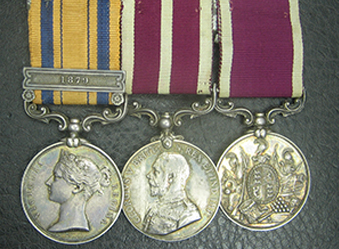
SOUTH AFRICA 1877-9, CLASP 1879 ’2026 SERGT G. J. BROWN. 90TH FOOT’, ARMY MERITORIOUS SERVICE MEDAL, G.V.R., 1ST ISSUE ‘CR. SJT. G. J. BROWN, SCOT. RIF.’, ARMY L.S. & G.C., V.R., 3RD ISSUE, SMALL LETTER REVERSE ‘2789 CR SERGT G. J. BROWN. SCO: RIF:’
George James Brown, a 20 year old carpenter from Uxbridge, enlisted into the 90th Light Infantry at Westminster on 8 October 1872. He was promoted Corporal on 1 September 1873 and Sergeant on 1 May 1875. Appointed Pioneer Sergeant on 11 October 1875, he was reappointed Sergeant on 1 April 1876 and to Colour Sergeant on 30 May 1881. Posted to 2nd Volunteer Battalion, Scottish Rifles as Sergeant Instructor on 19 April 1889, his Regimental number having changed to 2789. Colour Sergeant Instructor Brown was finally discharged on 10 October 1899 after 27 years service and was admitted for a Pension at The Royal Hospital Chelsea on 12 October.
He served in the Cape of Good Hope between 11 January 1878 and 19 March 1880, which included service during the entire Zulu War. He further served in India, 17 December 1880, to 15 April 89, the rest of his service being at Home. Service papers note entitlement to the South Africa 1879 and Long service medals, the latter being recommended in 1891. The date of the award of the Meritorious Service Medal is as yet unknown but was clearly after 1911. An obituary in The Motherwell Times, 20 May 1932 confirms the award, which is also being worn in a photograph of Brown.
The 90th saw service throughout the Kaffir War of 1877-8, seeing a good deal of action during the operations in the Waterkloof and Perie Bush. During the Zulu War of 1879, the 90th formed part of Wood’s column, taking part in the early war action at Zunguin Nek and being conspicuous for their actions at the engagements of Kambula and Ulundi. The battle of Kambula was a hard fought battle, the outcome of which was in the balance for a time. Ulundi turned out to be an outright victory. However although the British had won a series of battles, the spectre of Isandhlwana and the fear of the Zulu was still strong. This was of great concern, especially as far as the various ‘green’ regiments that took part. Along with the 13th Foot who they fought with side by side, the 90th by now the backbone of Lord Chelmsford’s force. By Wars’s end, these two regiments would see the most action of any British Regiment.
Note: Although entitled to the 1879, as noted on his service records, Brown was in South Africa from January 1878 and would have fought at the action at Zunguin Nek and the battles of Kambula and Ulundi.
Condition GVF, a little contact wear around 3 and 9 o’clock or better. Original ribbons, mounted as worn, SA detached. Clearly Brown switched his original LS ribbon for the post 1917 version (see photo of Brown wearing as such). A fine group of medals to a long serving soldier.